Lesson 11
Writing Equations for Lines
11.1: Coordinates and Lengths in the Coordinate Plane (5 minutes)
Warm-up
The purpose of this warm-up is to ensure students understand that
- they can infer the coordinates of a point based on knowing the coordinates of points on the same horizontal and vertical lines;
- the length of a horizontal or vertical line segment can be determined based on the coordinates of its endpoints. Each of these is important background knowledge for this lesson.
Launch
Give students 2 minutes of quiet think time. Ask them to share their reasoning with a partner followed by a whole-class discussion.
Student Facing
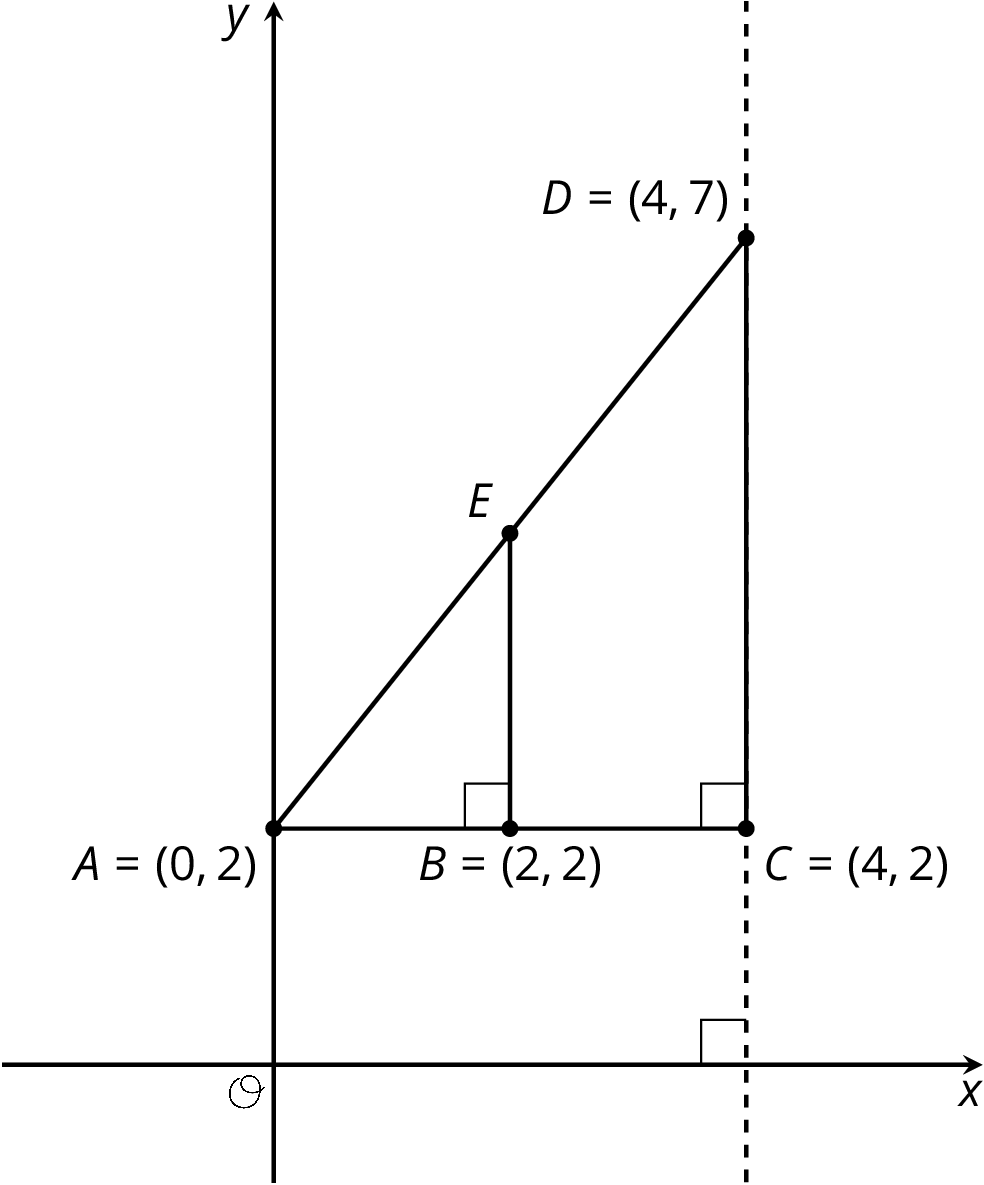
Find each of the following and explain your reasoning:
- The length of segment \(BE\).
- The coordinates of \(E\).
Student Response
For access, consult one of our IM Certified Partners.
Anticipated Misconceptions
In order to find the length of segment \(BE\), it is first necessary to find the lengths of \(CD\), \(AC\), and \(AB\), and reason about side lengths in similar triangles. If students have trouble getting started, scaffold the work by suggesting they first find any other segment lengths in the diagram that they can find.
Activity Synthesis
There are three important things students should understand or recall as a result of working on the warm-up:
- Points on the same vertical line have the same \(x\)-coordinate and points on the same horizontal line have the same \(y\)-coordinate.
- In order to find the length of a vertical segment, you can subtract the \(y\)-coordinates of its endpoints.
- The side lengths of triangle \(ACD\) are the same as the side lengths of the similar triangle \(ABE\) multiplied by the scale factor \(AC \div AB\).
Display the image from the task. For each question, invite a student to share their reasoning. The displayed image should be used as a tool for gesturing. For example, if you start at the origin and want to navigate to point \(D\), you would move 4 units to the right. You move the same distance to the right to navigate from the origin to \(C\). Therefore, \(C\) must have the same \(x\)-coordinate as \(D\).
11.2: What We Mean by an Equation of a Line (10 minutes)
Activity
Prior to this lesson, students have seen that right triangles with a horizontal side, a vertical side, and a long side along the same line are all similar. This activity exploits this structure to examine the coordinates of points lying on a particular line. The discussion then produces an equation for the line. In the case where the line goes through \((0,0)\), the equation will be familiar from prior work with proportional relationships but in the next lesson similar triangles will be essential.
Monitor for different ways of answering the last question including
- With words and arithmetic: for example, divide the \(y\)-coordinate by the \(x\)-coordinate and see if it is equal to \(\frac{3}{4}\).
- With words and proportional relationships: \(x\) and \(y\) are in a proportional relationship and when \(x = 4\) we know \(y = 3\).
- With an equation involving quotients of vertical and horizontal side lengths: for example, \(\frac{y}{x} = \frac{3}{4}\).
Invite these students to share their reasoning during the discussion. If a student writes \(y = \frac{3}{4}x\), this can be presented last but it is not essential that students see this now.
Launch
Encourage students to think about what they know about slope triangles from previous work. Give 2–3 minutes of quiet work time. Then ask students to share their responses and reasoning with a partner, followed by a whole-class discussion.
Supports accessibility for: Language; Organization
Design Principles(s): Optimize output (for explanation); Maximize meta-awareness
Student Facing
Line \(j\) is shown in the coordinate plane.
- What are the coordinates of \(B\) and \(D\)?
-
Is point \((20,15)\) on line \(j\)? Explain how you know.
-
Is point \((100,75)\) on line \(j\)? Explain how you know.
-
Is point \((90,68)\) on line \(j\)? Explain how you know.
-
Suppose you know the \(x\)- and \(y\)-coordinates of a point. Write a rule that would allow you to test whether the point is on line \(j\).

Student Response
For access, consult one of our IM Certified Partners.
Anticipated Misconceptions
For question 5, there is a potential issue in saying all points on the line satisfy \(\frac{y}{x}=\frac34\), which is that this equation is not true for the point \((0,0)\). Unless a student notices this, it is not necessary to bring it up at this time. If necessary, we could say that the equation describes the relationship between the \(x\)- and \(y\)-coordinate for every point on the line except \((0,0)\).
Activity Synthesis
After reviewing how students answered the first four questions, have them share their responses for question 5. Sequence responses starting with the least abstract:
- Divide the \(y\) coordinate by the \(x\) coordinate and see if the result is equal to \(\frac{3}{4}\). (Ask students to explain why this works: using similar triangles or slope triangles, the key is that the quotient of the vertical length and horizontal length of these similar triangles always takes the same value.)
- The ratios \(y:x\) and \(3:4\) are equivalent (since they represent corresponding sides of similar triangles or since the relationship between \(y\) and \(x\) is proportional and when \(y = 3\) then \(x = 4\))
- \(\frac{y}{x} = \frac{3}{4}\). This is a different way of stating the relationship.
This structure of coordinates for points on a line will be examined in much greater detail in upcoming lessons. Students are just starting to learn what it means to write the equation of a line—it’s not intended for them to understand everything there is to know, right now.
Make sure to draw a picture showing a point \((x,y)\) on the line and label the vertical side with its length, \(x\), and label the horizontal side with its length, \(y\).
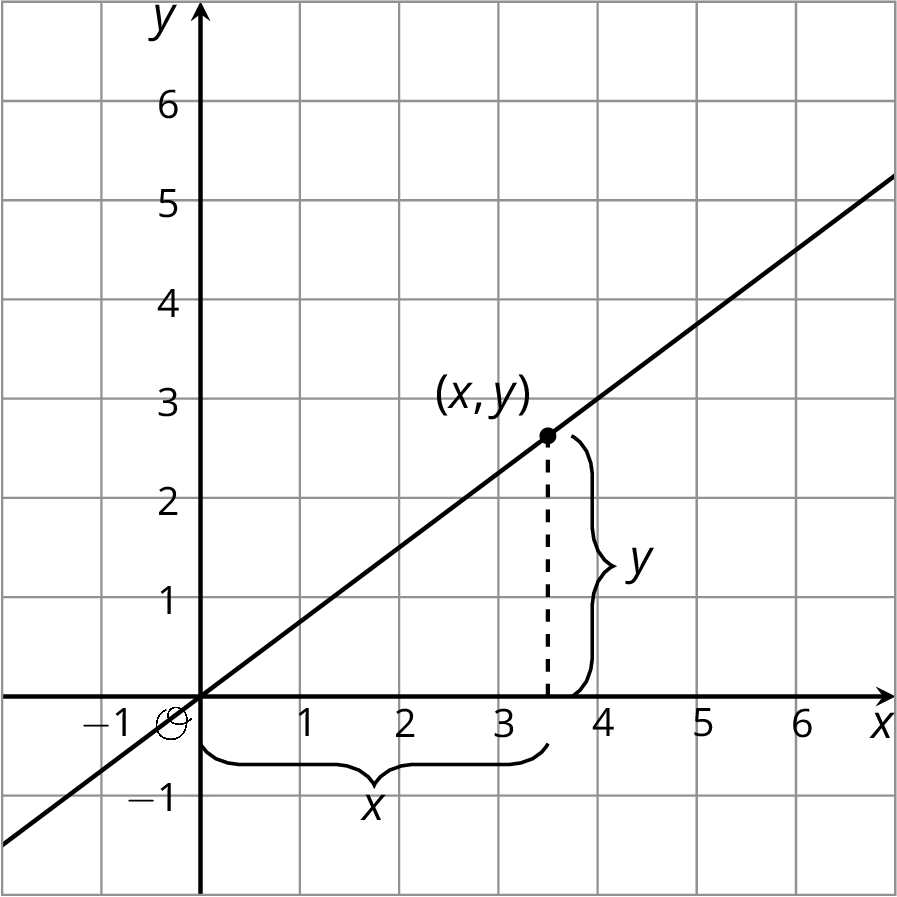
Ask students how the equation \(\frac{y}{x} = \frac{3}{4}\) relates to this situation. According to the reasoning in this task, the point \((x,y)\) is on the line when \(\frac{y}{x} = \frac{3}{4}\). These values are equal because they both represent the quotient of the vertical and horizontal side of slope triangles for the same line.
11.3: Writing Relationships from Slope Triangles (15 minutes)
Activity
In the previous activity, students found a rule which determines whether or not a point with coordinates \((x,y)\) lies on a certain line: there were many ways to express this rule, including an equation such as \(\frac{y}{x} = \frac{3}{4}\). In this activity, students find a rule to determine if a point \((x,y)\) lies on a line no longer containing \((0,0)\). Proportional reasoning based on the graph of the line, which could be applied to the line in the previous activity, no longer applies here. But, proportional reasoning using similar slope triangles does still apply and gives equations that look like \(\frac{y}{x} = \frac{3}{4}\) except that the quotient on the left is a little more complex. Like in the previous activity, students are using the structure of a line and properties of similar triangles to investigate these rules relating coordinates of points on the line (MP7).
Monitor for different expressions students write in the second question. For example, for line \(k\) students may write
- \(\frac{y-1}{x} = \frac{3}{4}\)
- \(4(y-1) = 3x\)
- \(4y = 3x + 4\)
Invite students with different expressions to share during the discussion. Note that the rule or equation for the line is unlikely to come in the form \(y = mx + b\). This is not important for now and will be addressed in future work. The important take away for this lesson is that we can write a criterion for when a point lies on a line by thinking about similar triangles and their properties.
Launch
Tell students that next, we are going to find equations satisfied by points on some more lines. These lines do not represent proportional relationships, but we can still use what we know about similar triangles to find equations.
It really helps if students write the side lengths correctly. Therefore, ask students to complete the first question and then pause. Ensure that everyone knows and understands a correct expression for each side length before proceeding. Then, instruct students to complete the second question.
Supports accessibility for: Social-emotional skills; Conceptual processing
Design Principle(s): Maximize meta-awareness
Student Facing
Here are two diagrams:
- Complete each diagram so that all vertical and horizontal segments have expressions for their lengths.
- Use what you know about similar triangles to find an equation for the quotient of the vertical and horizontal side lengths of \(\triangle DFE\) in each diagram.
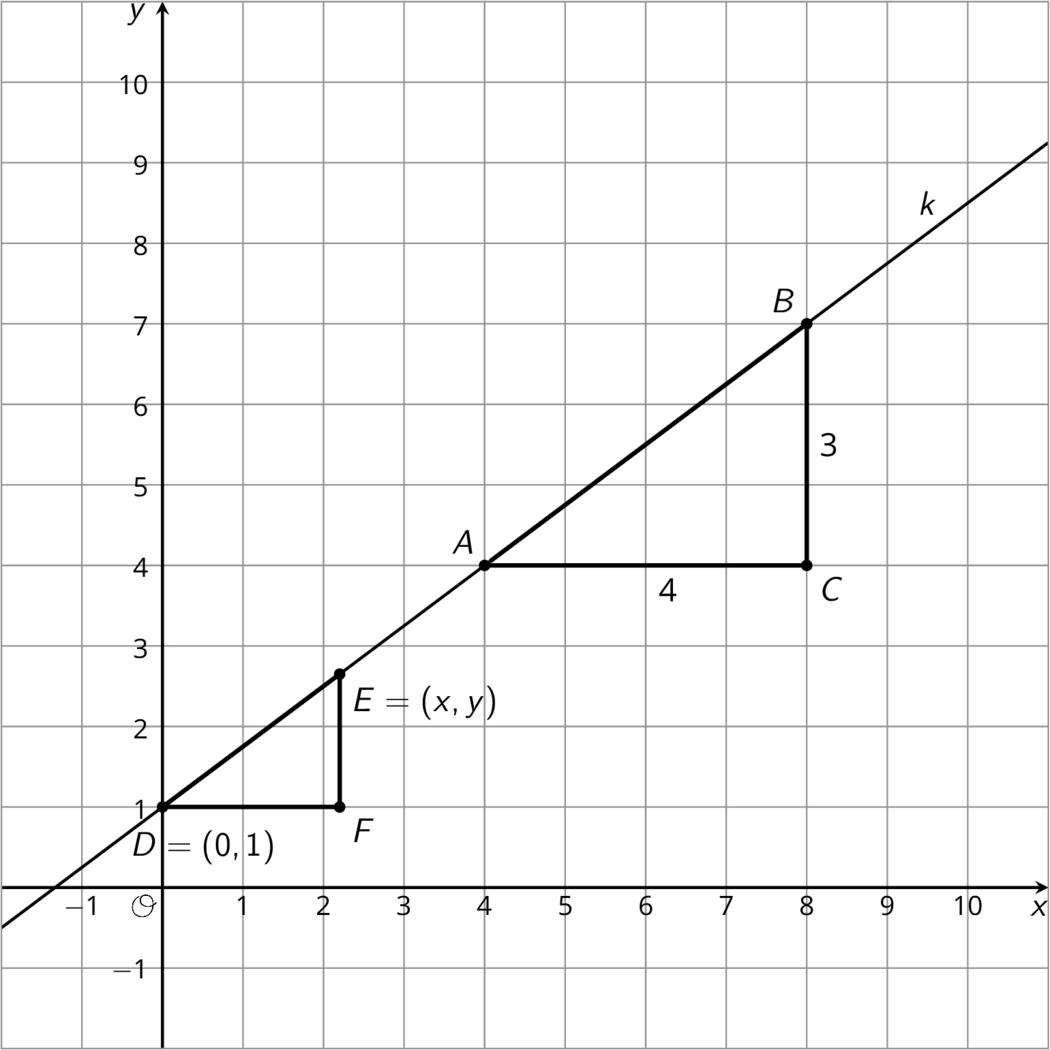
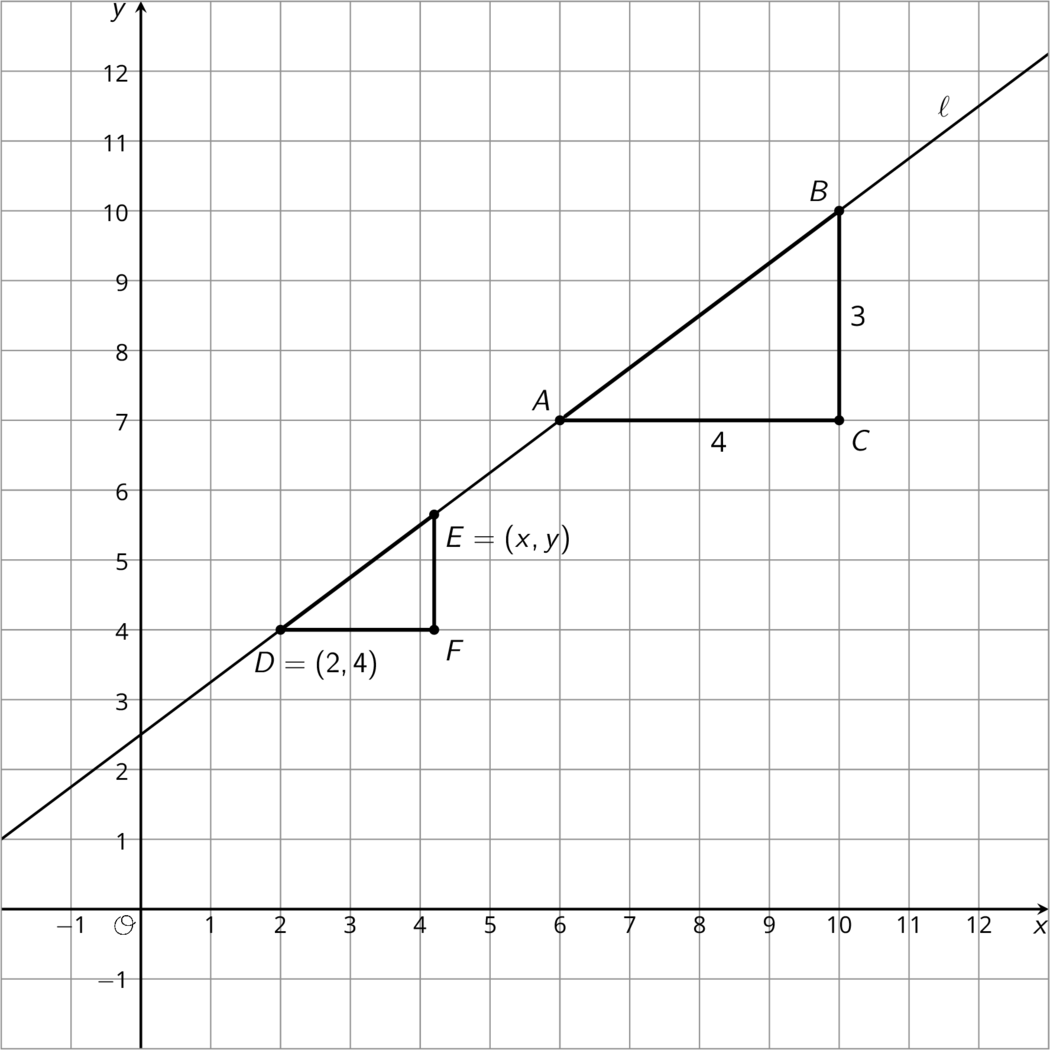
Student Response
For access, consult one of our IM Certified Partners.
Student Facing
Are you ready for more?
- Find the area of the shaded region by summing the areas of the shaded triangles.
- Find the area of the shaded region by subtracting the area of the unshaded region from the large triangle.
- What is going on here?
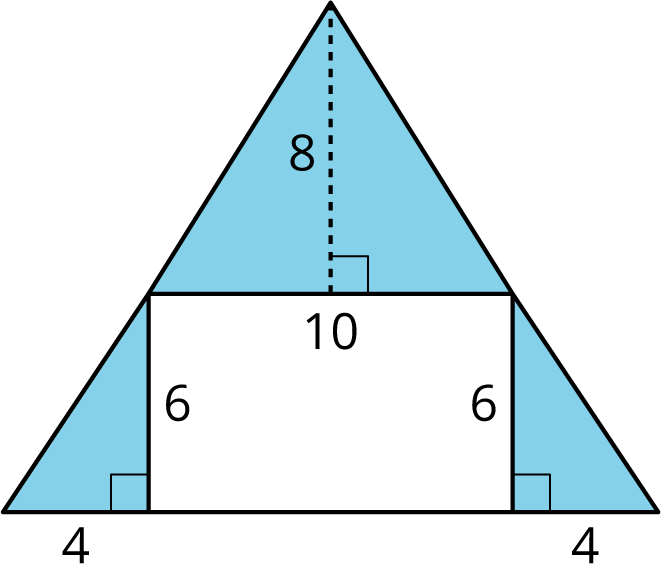
Student Response
For access, consult one of our IM Certified Partners.
Activity Synthesis
Ask selected students what they wrote for an equation satisfied by \(x\) and \(y\) for the two graphs, making sure to note different forms. One equation is \(\frac{y-1}{x} = \frac{3}{4}\). There is no reason to manipulate this, but some students might rewrite this as \(4y-4 = 3x\) or even \(y = \frac{1}{4}(3x+4)\). For the second graph, students may write \(\frac{y-4}{x-2} = \frac{3}{4}\) or \(4(y-4) = 3(x-2)\). At this point, the important thing to notice is that the coordinates for any point \((x,y)\) on the line will satisfy this relationship. This is because we did not use any special properties of the point \((x,y)\) (just that it lies on the line) to find the relationship. There is no reason to manipulate the equations \(\frac{y-1}{x} = \frac{3}{4}\) or \(\frac{y-4}{x-2} = \frac{3}{4}\) because these two equations contain all of the information from the similar triangles. (Once the equations are manipulated, this structure is lost, and it is this structure that is of central importance here.)
Make sure that students understand that the slope of lines \(k\) and \(\ell\) (as well as \(j\) from the previous activity) are all \(\frac{3}{4}\). The location of the lines in the plane is different, and this is reflected in the different equations for the three lines. If the equations are in the form \(\frac{y}{x} = \frac{3}{4}\), \(\frac{y-1}{x} = \frac{3}{4}\), and \(\frac{y-4}{x-2} = \frac{3}{4}\), we can see that what is the same in each is the \(\frac{3}{4}\) and that there is a \(y\) in each numerator on the left and an \(x\) in the denominator.
Note, if needed, that the equation does not make sense if the denominator is equal to zero. For example, \(\frac{y-1}{x} = \frac{3}{4}\) does not make sense if \(x = 0\) and \(y = 1\). The reason for this is that \((0,1)\) is the one point on the line where we can not build a slope triangle together with the point \((0,1)\).
Time permitting, ask students how the equations for \(k\), \(\ell\), and \(j\) are alike and how they are different. A key way they are alike is that they can all be written as some quotient involving \(y\) and \(x\) equal to \(\frac{3}{4}\). The reason for the common value of \(\frac{3}{4}\) is that the lines all have the same slope, namely \(\frac{3}{4}\). A key difference is the values subtracted from \(x\) and \(y\) on the left hand side of the equations: these are different because each line is in a different location on the coordinate plane.
Lesson Synthesis
Lesson Synthesis
Today, we used slope triangles to find a relationship satisfied by the coordinates of all points on a line.
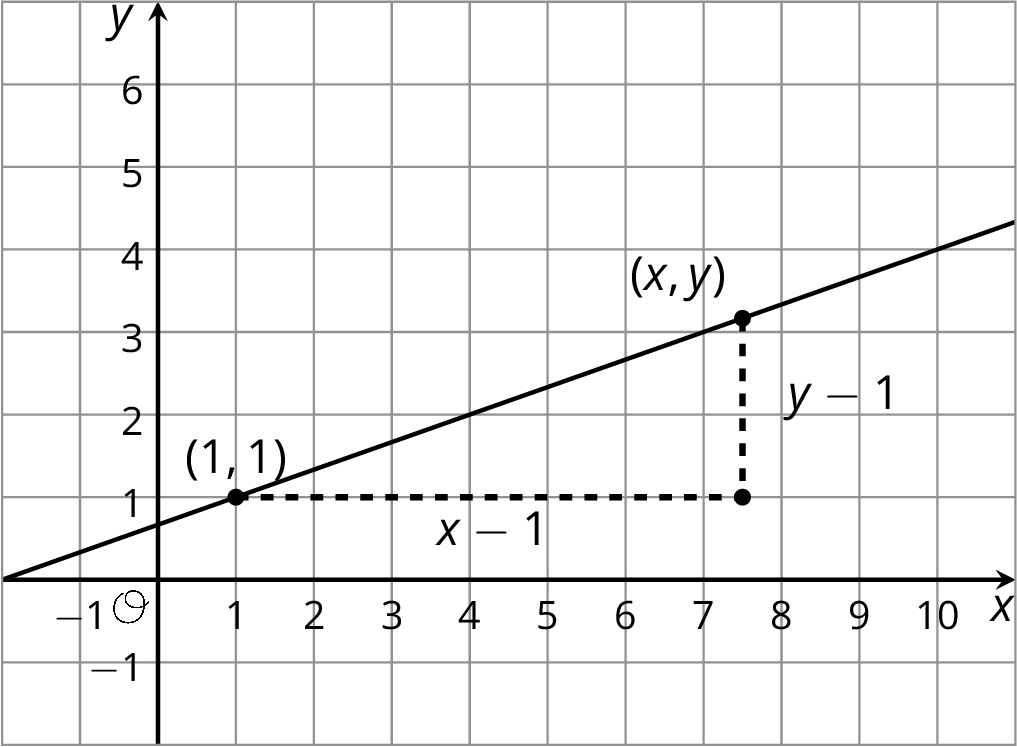
What is the slope of this line? It’s \(\frac{2}{6}\) because the points \((1,1)\) and \((7,3)\) are on the line. The point \((x,y)\) lies on this line so the slope we calculate with the slope triangle for \((x,y)\) must also be equal to \(\frac{2}{6}\). The slope for this triangle is \(\frac{y-1}{x-1}\) since the vertical side has length \(y-1\) and the horizontal side has length \(x-1\). This means that \(\displaystyle \frac{y-1}{x-1} = \frac{2}{6}\) This relationship is true regardless of which point \((x,y)\) we choose on the line!
11.4: Cool-down - Matching Relationships to Graphs (5 minutes)
Cool-Down
For access, consult one of our IM Certified Partners.
Student Lesson Summary
Student Facing
Here are the points \(A\), \(C\), and \(E\) on the same line. Triangles \(ABC\) and \(ADE\) are slope triangles for the line so we know they are similar triangles. Let’s use their similarity to better understand the relationship between \(x\) and \(y\), which make up the coordinates of point \(E\).
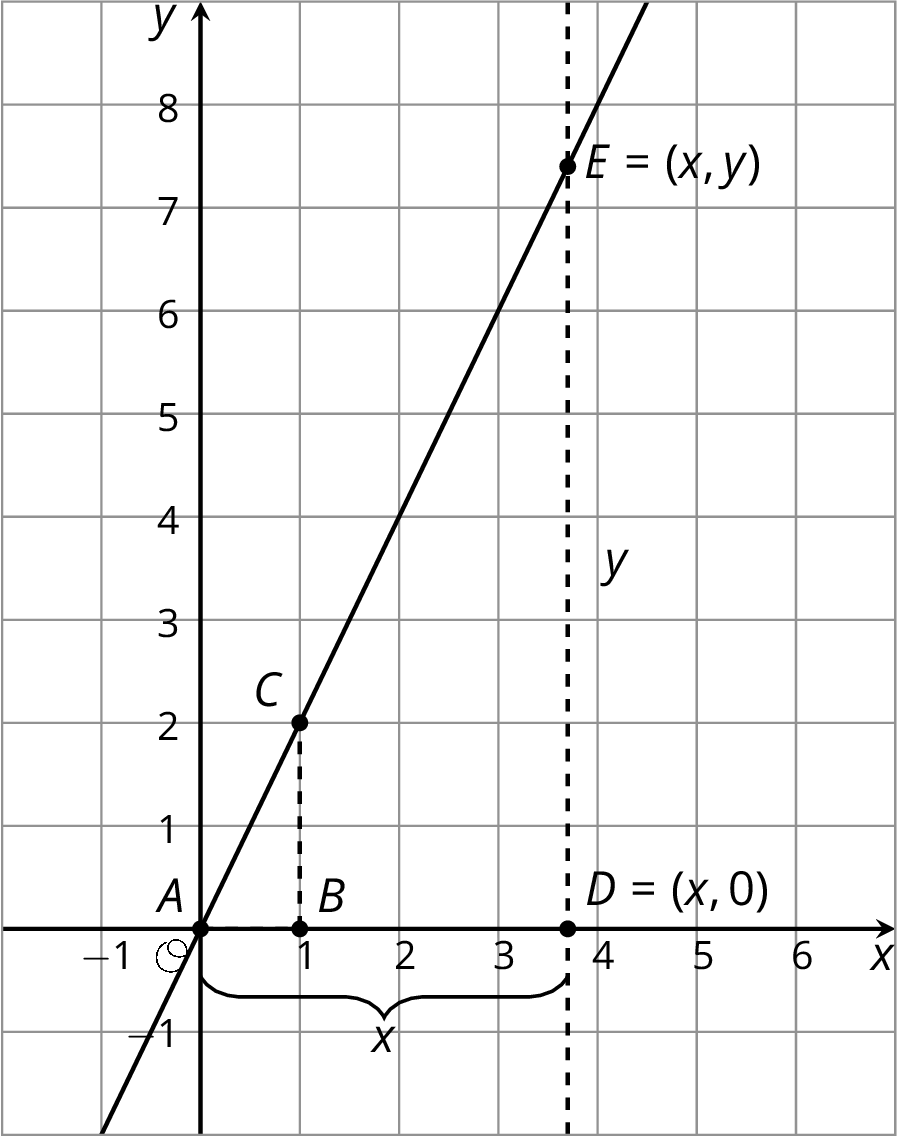
The slope for triangle \(ABC\) is \(\frac{2}{1}\) since the vertical side has length 2 and the horizontal side has length 1. The slope we find for triangle \(ADE\) is \(\frac{y}{x}\) because the vertical side has length \(y\) and the horizontal side has length \(x\). These two slopes must be equal since they are from slope triangles for the same line, and so: \(\frac{2}{1} = \frac{y}{x}\).
Since \(\frac{2}{1} = 2\) this means that the value of \(y\) is twice the value of \(x\), or that \(y= 2x\). This equation is true for any point \((x,y)\) on the line!
Here are two different slope triangles. We can use the same reasoning to describe the relationship between \(x\) and \(y\) for this point \(E\).

The slope for triangle \(ABC\) is \(\frac{2}{1}\) since the vertical side has length 2 and the horizontal side has length 1. For triangle \(ADE\), the horizontal side has length \(x\). The vertical side has length \(y-1\) because the distance from \((x,y)\) to the \(x\)-axis is \(y\) but the vertical side of the triangle stops 1 unit short of the \(x\)-axis. So the slope we find for triangle \(ADE\) is \(\frac{y-1}{x}\). The slopes for the two slope triangles are equal, meaning: \(\displaystyle \frac{2}{1} = \frac{y-1}{x}\)
Since \(y-1\) is twice \(x\), another way to write this equation is \(y-1 = 2x\). This equation is true for any point \((x,y)\) on the line!